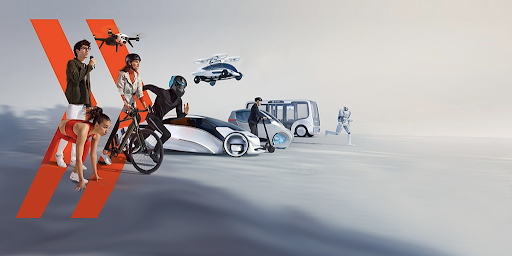Perhaps there is no greater sense of freedom than stepping into a car with a flawless and gleaming driver’s license in hand. It marks teenage independence and the beginning of parental worry. While automobiles themselves have evolved over the last several decades, that fleeting moment of empowerment we all felt at the wheel now is broadening to all drivers all the time as the future of automotive – and the driver experience – transforms in profound ways.
How can your vehicle, the one that hauls groceries, kids and coworkers, be anything but what it is: a means to your destination?
The answer might be found in the form of the unimaginable number of bits and bytes we create every day. According to Statista, global data creation is projected to grow to more than 180 zettabytes by 2025 (one zettabyte is the equivalent to around 60 billion video games). Remote work, learning and entertainment accelerated the data explosion with the sharp increase of digital devices, IoT, data management technology, cloud and analytics.
No doubt, we are moving toward a world where everyone and everything is intelligently connected. Qualcomm calls it the Connected Intelligent Edge. The San Diego-based pioneer of smart technology is led by CEO Cristiano Amon whose vision is driving the automotive industry’s digital transformation movement. A shift is underway toward an electrified, cloud-connected, service-driven future for mobility. What this means for drivers, passengers and customers is greater pleasure, less stress and a more seamless merging of life, work and the vehicles that get us where we need to go.
The future of automotive is no longer just the body and style of a vehicle, but the innovation inside: intelligently connected, autonomous, digital and environmentally friendly technology. The pathway to making the autonomous future happen is 5G.
I’ve studied the progression of 4G since its inception in 2009. It was the threshold to high-quality video streaming, an entertainment game-changer. What used to be our favorite TV shows viewed on specific days of the week at specific times soon gave way to blockbuster shows shared with friends and viewed on-demand. With 5G, the possibilities are even more impactful – and the rate by which this technology is advancing is even faster than its predecessor.
In listening to Amon’s keynote speech at IAA Mobility 2021, he compared 5G connectivity and automotive innovation to the necessity of roads in transportation infrastructure. I believe it is essential as experiences become more personalized across many industries, particularly by automakers. We will need greater capacity for cloud services and immersive media streaming as consumers have come to expect on-the-go content from their smartphones.
These are all pleasurable experiences that will elevate the driving experience.
No doubt, I will love having my favourite music (John Lennon’s Imagine) and shows (Sherlock and The Blacklist) as part of my in-car experience. And that’s what the Connected Intelligent Edge delivers: bigger screens, video and music streaming (no more searching for the AUX cord under the seat!), more immersive experiences, cloud-based multi-player games that are nearly lag-free.
But there’s another side to pleasure, and that is the confidence of safety.
Amon pointed out that 5G introduces 5G Cellular-V2X, which is a technology designed to help enhance safety, improve traffic efficiency to relieve congestion and make next generation transportation networks and cars more aware and more intelligent about their surroundings.
He said that 5G will help the auto factory of the future become more adaptable to support greater flexibility and customization, and that Virtual and Augmented Reality with 5G will make car sales and maintenance more immersive. The digital cockpit, he said, is where new car experiences will come together, providing a window to services and content, software updates and preemptive maintenance.
The key focus in mobility will be richer experiences because of access to richer data. Just as navigation systems replaced printed maps, real time traffic reporting will make for more efficient routing.
Amon sees the future because Qualcomm is architecting the future. He sees vehicles communicating with each other, with pedestrians and with infrastructure, while cities optimize for efficiency and work towards safer traffic flows. Today, no company can pioneer in isolation. Qualcomm is collaborating with network operators and manufacturers – including automakers, infrastructure, enterprise and indirect customers and cloud players. Through integrated platforms such as the Snapdragon® Digital Chassis, the company has grown exponentially in telematics, infotainment and in-car connectivity businesses, which is all seen through its latest auto design-win pipeline of over $10B.
This, to me, reflects the new gold standard in business – to collaborate with other stakeholders in the supply chain and industry in order to find a better solution. Building a stronger partner ecosystem creates more resilience, reduces production costs and garners better efficiency. Imagine if you could get parts from local manufacturers to assemble a car and save on shipping costs, for example.
Qualcomm is also involved with Standards bodies, defining key technologies for commercialization and helping regulators understand the potential of new technology. Such standards set critical precedent in the midst of rapid technological evolution.
This drive to bring the automotive industry to the next level delivers new possibilities for pleasure, underscoring a favorite quote of mine by Samuel Johnson: “Pleasure is very seldom found where it is sought; our brightest blazes of gladness are commonly kindled by unexpected sparks.”
Those sparks are being ignited for the automotive industry today. We are the lucky ones who get a front row seat to them as the sea change becomes a wave for a whole new mobility experience, lengthening the excitement we felt that very first time we sat behind the wheel.
#Sponsored by Qualcomm Technologies, Inc.

